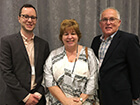
Ellworth Beckmann (left to right)
On September 27, I attended the Association of Research Libraries (ARL) and Coalition for Networked Information (CNI) Fall Forum as the winner of the Julia C. Blixrud Scholarship. I want to thank the family of Julia Blixrud, especially her sister Wendy Blixrud Beckmann and Wendy’s husband, Ellworth Beckmann, whom I got to meet personally. It is clear that Julia left a lasting impression on ARL, shown through this scholarship and the words spoken about her. It is an honor to be chosen among my peers for this scholarship. Though I did not know Julia personally, I kept in mind what has been written about her as I developed a video for my scholarship submission.
The theme for this year’s Fall Forum was “Innovation in Research Libraries.” Susan Gibbons (Yale University; ARL) and Joan Lippincott (CNI) opened the forum and introduced me as the Julia C. Blixrud Scholarship recipient and Bernard Banks (Northwestern University) as the Julia C. Blixrud Memorial Lecturer. Dr. Banks spoke on organizational culture that supports innovation (slides). Bernard Banks is a dynamic speaker and kept the audience engaged as he highlighted many great concepts related to innovation over the course of his lecture. Why do libraries need to be innovative? “The world is changing,” Banks stated, “libraries need to adapt.” We work in a service profession and our customers’ needs are changing, so libraries must change to remain relevant. What is the number one reason that innovation fails? Resistance—the culture must support smart risk-taking. Trust is a significant component here and the organization must trust its leader. But how do leaders change the culture if it will not support innovation? Banks cited Kurt Lewin’s three-step change-management model, first described in “Frontiers in Group Dynamics.”* Lewin argues to change organizational culture, you must unfreeze the current culture, then change, then refreeze the culture. Banks stressed the importance of the first step, unfreezing, and highlights three ways to do so: compelling logic, analytics, and trust. He gave all in attendance much to think about as leaders change organizational culture to one that supports innovation in their institutions.
Dr. Banks’s presentation was followed by a panel of post-secondary administrators who spoke on why we need to be innovative. The panel was moderated by Joan Lippincott and speakers included Feridun Hamdullahpur (University of Waterloo), Rafael Bras (Georgia Institute of Technology), Geoffrey Chatas (Georgetown University), and Padma Raghavan (Vanderbilt University), all regarded as highly innovative leaders at their institutions.
Specific innovations that were mentioned included the University of Waterloo’s initiative to create an artificial kidney and Vanderbilt’s PATH EX, which is developing a blood-cleansing device designed to solve sepsis. Key takeaways from this panel included Chatas’s suggestion to put resources in specific areas; do not try to be all things to all people. Hamdullahpur suggested libraries should explore avenues to maintain relevance. Libraries have a responsibility to the institution and society to be relevant. This panel was an interesting look into academic administration and why these leaders are making their decisions. I do not often get a first-hand look into this perspective of academic institutions.
After interesting conversation at our lunch tables prompted by questions provided by ARL, the afternoon session opened with a second panel. The afternoon panel was on the “what” of innovation. The panel was moderated by MacKenzie Smith (University of California, Davis) and consisted of Patricia Brennan (National Library of Medicine), James Hilton (University of Michigan), Wendy Lougee (University of Minnesota), and Catherine Murray-Rust (Georgia Institute of Technology). The library administrators described innovations they have used in their library systems. Lougee rightly claimed libraries have potential to academic institutions that has not yet been fully realized. Hilton agreed, saying there is a risk of not moving—this is not about existence, but about relevance. Echoing Dr. Banks’s earlier statement of relevance, Hilton said to not embrace the idea that “libraries are inherently relevant.” As an example of innovation, Murray-Rust described Georgia Tech’s change in organizational structure by instituting supply-chain theory to library staff.
Key takeaways from this panel included Hilton’s suggestion to know your North Star, meaning know what general direction you want to go, but do not rely too heavily on the smaller details. Brennan suggested leaders need to take time to think. Library leaders should schedule small appointments on their calendar to take time to think about future initiatives. Lougee said investments in employees, education, and mentorships, as well as nurturing internal and external relationships, are key. Murray-Rust advised library staff to ensure potential hires know the current organizational culture, as well as to support library workers.
Mary Lee Kennedy (ARL) concluded the forum by summarizing the day’s events and there was time for participants to share how they think ARL could support innovation at their institutions. Thank you for having me, ARL! It was a wonderful time, one that I will not forget anytime soon. It was an interesting and unique look into the world of postsecondary administration and academic library administration, one I do not get to see very often. I hope to bring what I heard with me throughout my career.
Note
* Kurt Lewin, “Frontiers in Group Dynamics: Concept, Method and Reality in Social Science; Social Equilibria and Social Change,” Human Relations 1, no. 1 (June 1, 1947): 5–41, https://doi.org/10.1177/001872674700100103.
See also tweets shared with the #ARLCNIforum18 hashtag.


